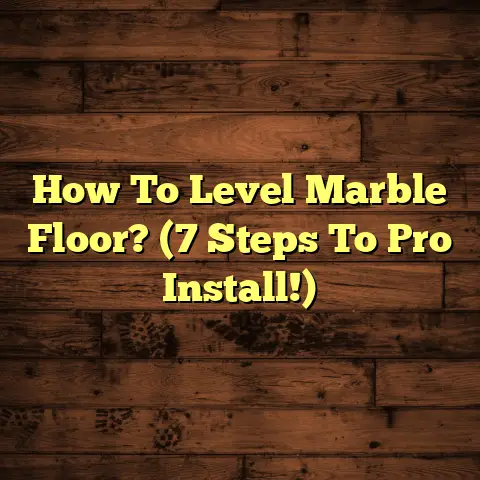How To Install A Shower Base On Concrete Floor Australia? (Explained)
Have you ever found yourself wondering how to save time while installing a shower base on a concrete floor?
I remember my first experience installing a shower base. It felt overwhelming, especially with the concrete floor involved. Over time, I’ve developed a method that makes the process not only efficient but also rewarding. Let me share my journey and insights with you.
Preparing for the Installation
Gathering Materials
Before jumping into the actual installation, gathering all necessary materials is crucial. Here’s what you’ll need:
- Shower Base: Choose a model that fits your bathroom layout. I usually go for acrylic or fiberglass bases as they tend to be lighter and easier to work with.
- Mortar Mix: This will help support the base and ensure it’s level.
- Waterproofing Membrane: An important step to prevent leaks. I often use a sheet membrane for better durability.
- Drain Kit: Make sure it’s compatible with your shower base.
- Tools: You’ll need a trowel, level, measuring tape, and possibly a saw for adjustments.
Planning the Layout
Before I start, I always take time to plan the layout carefully. Measure the area where the shower base will be installed. My rule of thumb is to leave at least a 1-inch gap around the perimeter to accommodate any adjustments.
Once I have my measurements, I mark them on the concrete floor with a chalk line. This helps visualize the space and ensures accurate placement.
Installing the Shower Base
Step 1: Preparing the Concrete Floor
Concrete can be unforgiving if not prepared correctly. I always start by cleaning the area thoroughly. Remove any debris or old adhesive that might interfere with the installation.
If I notice any cracks in the concrete, I fill them with a concrete patch to create a smooth surface. A level surface is crucial for proper drainage, so I double-check with my level.
Step 2: Setting Up the Drain
Next up is installing the drain. I typically opt for a center drain setup, which works well for most shower bases.
- Mark the Drain Location: Based on your shower base, determine where the drain needs to be placed.
- Cut the Concrete: Using a concrete saw, cut out an opening for the drain. This part can be a bit noisy, so I always wear hearing protection.
- Install the Drain Flange: Follow the manufacturer’s instructions for securing the drain flange to the pipe underneath. This may involve using plumbing glue or screws.
Step 3: Mixing and Spreading Mortar
Once the drain is set, it’s time to mix the mortar. Follow the instructions on your mortar mix bag closely; achieving the right consistency is key.
Spread the mortar evenly across the area where the shower base will sit, using a trowel to create a flat surface. I usually aim for about 1 inch of mortar thickness for good support.
Step 4: Placing the Shower Base
Carefully lower the shower base onto the mortar bed, ensuring that it aligns perfectly with the drain. This part can be tricky, so having an extra set of hands is helpful.
Once in place, press down gently to ensure it bonds with the mortar. I always check again with my level to confirm it’s even.
Step 5: Securing and Waterproofing
After placing the shower base, it’s essential to secure it properly. Use screws or brackets as directed by your shower base manufacturer.
Next, apply a waterproofing membrane around the edges where the base meets the wall. This is a critical step in preventing future leaks. I usually extend the membrane about 6 inches up the walls.
Finishing Touches
Step 6: Grouting and Sealing
Once everything is set and dried according to your mortar’s instructions, it’s time to grout around the edges of your shower base.
Choose a waterproof grout for this part—trust me, it’s worth it! After applying, let it cure for at least 24 hours before using your shower.
I always finish by sealing any joints or seams with silicone caulk to create a watertight seal.
Step 7: Testing for Leaks
Before calling it a day, I suggest testing for leaks. Run some water through the drain and check for any signs of leakage around the edges. If you notice any issues, it’s better to address them now than later.
Challenges Encountered
Throughout my experiences, I’ve faced several challenges when installing shower bases on concrete floors. For instance, one time, I miscalculated my measurements, which led to an uneven base. It took extra time to fix it, but I learned to double-check everything before proceeding.
Another issue was dealing with older homes where concrete might not be level due to settling over time. In those cases, I had to use self-leveling compound to create an even surface before proceeding with installation.
Cost Estimation with FloorTally
Cost estimation can seem daunting, especially with unexpected expenses popping up during installations. That’s where FloorTally comes in handy for me.
This tool provides accurate cost estimates based on local material and labor rates. When planning a shower base installation, I input all my materials and labor hours into FloorTally, which gives me a clear budget from day one.
For example, when installing my last shower base, FloorTally helped me account for everything from mortar mix to waterproofing materials and even disposal fees for old materials. Knowing these costs upfront allowed me to communicate transparently with my clients, which they always appreciate.
Helpful Tips
- Take Your Time: Rushing through measurements can lead to mistakes.
- Use Quality Materials: Investing in good materials often saves money in the long run.
- Don’t Skip Waterproofing: Trust me; future leaks can be a real headache.
- Ask for Help: Having someone assist you can make heavier lifting and aligning easier.
Detailed Process Breakdown
Understanding Shower Base Options
When selecting a shower base, it’s essential to understand your options thoroughly. There are various types of shower bases available, such as:
- Acrylic: Lightweight and easy to install, acrylic bases are popular due to their affordability and versatility in design.
- Fiberglass: Similar to acrylic but generally less durable; however, they are often less expensive.
- Tile Shower Bases: Customizable and aesthetically pleasing but require more labor and expertise during installation.
I often weigh these options based on client preferences and budget constraints. For instance, while tile bases may look stunning, they require more maintenance and time to install compared to acrylic options.
Choosing the Right Drain System
The drain system you choose is critical for proper water management in your shower. Common types include:
- Center Drain: Ideal for most setups; located in the middle of the shower base.
- Linear Drain: A modern option that runs along one side of the shower; great for larger spaces and provides a sleek finish.
- Point Drain: Similar to center drains but can be placed in various locations based on design needs.
I prefer using linear drains in modern installations because they offer excellent water flow and aesthetic appeal.
Troubleshooting Common Issues
Uneven Floors
If your concrete slab isn’t level, you might face drainage issues later on. To tackle this problem:
- Self-Leveling Compound: Pour this over low spots before installing your shower base.
- Check Levels Frequently: Use a long level during installation to catch unevenness early.
Drainage Problems
Clogged drains can be frustrating! To avoid this:
- Install Hair Strainers: These can catch hair and debris before they enter the drain.
- Regular Maintenance: Encourage clients to clean out drains regularly to avoid buildups.
Learning from Experience
Every installation teaches me something new. A memorable experience was when I attempted my first tile shower base installation without sufficient research.
I thought it would be straightforward—grab some tiles and glue them down! However, halfway through, I realized that proper spacing and sealing were crucial for preventing leaks. After correcting my mistakes and learning about grout lines and proper sealing techniques, I became much more confident in my abilities.
Now, I always stress proper planning and research before tackling any new project—each lesson learned helps me improve my craft.
Maintenance Tips for Shower Bases
Once your shower base is installed and functional, maintaining it is key to prolonging its life:
- Regular Cleaning: Use non-abrasive cleaners to avoid scratching surfaces.
- Check Seals: Inspect silicone seals every few months and replace any damaged areas.
- Watch for Cracks: Keep an eye on your shower base; if you notice cracks or signs of wear, address them immediately.
Dealing with Client Expectations
Managing client expectations is a significant part of my job as a contractor. Clear communication about timelines and potential challenges helps build trust.
For example, when discussing installation timelines for shower bases, I always factor in drying times for mortar and waterproofing membranes. Clients appreciate knowing that patience is required for a job well done rather than rushing through an installation that could lead to problems later.
Conclusion
Installing a shower base on a concrete floor can be challenging but also very rewarding when done correctly. My advice? Take your time with each step and ensure everything is level and secure.
Comparing different approaches has taught me that preparation is key. Whether you’re using a premade shower base or constructing one from scratch, being methodical and organized is essential.
With practice and experience, you’ll find your rhythm in this process. And who knows? You might even enjoy it as much as I do!





